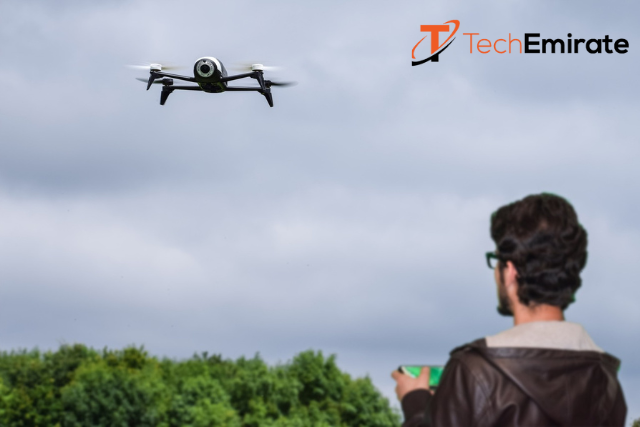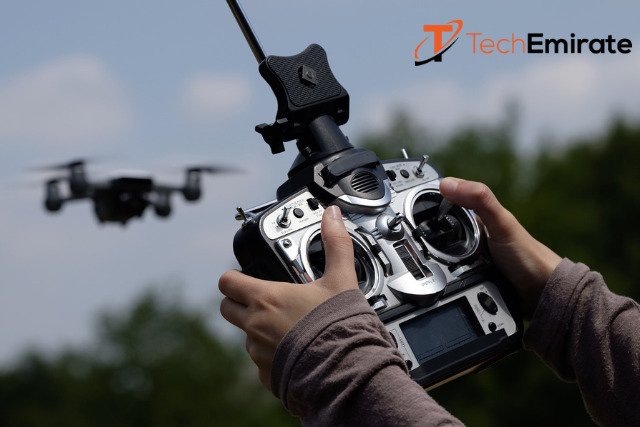Drones have become more popular in recent years. Many users take advantage of their unique capabilities. One of the most common questions people have about drones is how far drone can fly. If you don’t know the answer don’t worry, I’m here to help!
In this article, I’m about to tell you everything about how far drones can fly. I’ll discuss the different types of drones available. How battery life affects flight range, and the impact of environmental conditions on drone performance.
Also, I’ll provide some tips for safely flying your drone to maximize its flight range.
So, keep reading and find the answer to your question how far drones can fly?
Table of Contents
How Far Can a Drone Fly from the Controller?

Before I dive into the details of drone range, let me explain what it means. A drone’s range is how far it can go from the person flying it or where it took off while still staying connected and under control.
Factors Affecting Drone Range
How far can a drone fly from the controller depends on some factors, including:
1. Battery Life: The battery is the primary power source for most drones. The longer the battery can provide power, the farther the drone can fly. Advances in battery technology are pushing the limits of drone range.
2. Drone Type: Different types of drones have varying ranges. Consumer drones have shorter ranges, while professional and military drones are designed for longer flights.
3. Environmental Conditions: Environmental factors such as wind, temperature, and altitude can affect a drone’s range. High winds and extreme temperatures can reduce a drone’s ability to fly long distances.
Drone Types and Their Ranges
Drones come in various types, each designed for specific purposes. Let’s take a look at some of these types and their respective flight ranges:
Consumer Drones
Consumer drones, designed for recreational use and aerial photography, typically have a range of 1 to 5 kilometers (0.6 to 3.1 miles). Popular models like the DJI Mavic Air 2 can reach a range of up to 10 kilometers (6.2 miles).
Professional Drones
Professional drones are often used for tasks like aerial photography, surveying, and mapping. These drones tend to have longer ranges, typically ranging from 5 to 10 kilometers (3.1 to 6.2 miles). The DJI Phantom 4 Pro, for example, boasts a range of up to 7 kilometers (4.3 miles).
Military Drones
Military drones are designed for surveillance, reconnaissance, and even combat. These drones can have extensive ranges, with some military UAVs capable of flying thousands of kilometers (miles) away from their operators.
Battery Life and Range
As mentioned earlier, the battery life of a drone is a significant factor in how far can a drone fly. To understand this better, consider the analogy of a car’s fuel tank.
A drone’s battery is like its fuel tank, and the drone consumes energy to stay in the air. The longer the battery can provide power, the farther the drone can fly. This is why advancements in battery technology are critical for extending drone range.
In recent years, we’ve seen improvements in battery capacity and efficiency, leading to drones that can stay airborne for longer periods. For example, lithium-polymer (LiPo) batteries have become standard in many drones due to their high energy density and lightweight properties.
Environmental Factors
Environmental conditions play a crucial role in a drone’s ability to fly long distances. Here are some key environmental factors that can affect drone range:
1. Wind: Strong winds can significantly impact a drone’s range. Headwinds can slow the drone down, reducing its effective range, while tailwinds can extend its range.
2. Temperature: Extreme temperatures, whether hot or cold, can affect battery performance. Cold temperatures can cause batteries to discharge faster, while high temperatures can increase the risk of overheating.
3. Altitude: Drones are affected by air pressure changes at higher altitudes. The higher you fly, the less dense the air becomes, which can impact a drone’s performance.
To optimize your drone’s range in various environmental conditions, it’s essential to check weather forecasts, choose the right flying time, and take necessary precautions.
Regulations and Legal Limits
It’s important to note that there are legal restrictions and regulations governing drone operations in most countries. These regulations often specify the maximum allowable range for drones. To ensure safe and legal drone flights, drone operators must adhere to these regulations.
Regulations can vary from one region to another, but they typically focus on aspects like line-of-sight operation and altitude limits. It’s crucial to be aware of the specific regulations in your area to avoid any legal complications.
Extending Drone Range
While the range of a drone is limited by various factors, there are ways to extend it for your specific needs. Here are some practical tips for extending a drone’s range:
1. Fly in Optimal Conditions: Choose days with favorable weather conditions. Calm winds, moderate temperatures, and clear skies are ideal for extending your drone’s range.
2. Plan Your Flight: Careful flight planning can make a significant difference. Plot your route, and be mindful of any potential obstacles or interference sources.
3. Use Range Extenders: Range extenders are accessories that can enhance the signal between the remote control and the drone. They can help you maintain a stable connection at longer distances.
4. Upgrade to a High-End Model: If range is a top priority for your drone operations, consider investing in a high-end drone model designed for longer flights.
5. Check Battery Health: Regularly check and maintain your drone’s battery to ensure it’s in optimal condition. Replace the battery when it starts showing signs of deterioration.
How to Fly Your Drone Safely for Maximum Range
Here are a few tips for flying your drone safely for maximum range:
- Choose a safe and controlled environment. Avoid flying near airports, power lines, and other obstacles.
- Always fly in line of sight.
- Be aware of the weather conditions and avoid flying in windy or rainy weather.
- Use a power-saving mode.
- Fly light. The less weight the drone is carrying, the further it will fly.
Real-World Examples
Drones have found applications in a multitude of industries, each with its own range of requirements. Let’s explore a few real-world examples:
1. Agriculture
Drones are used for crop monitoring, pest control, and precision agriculture. The range is crucial for covering large farming areas efficiently.
2. Fishing
Anglers are now using drones to scout fishing locations and drop bait. A longer range allows them to explore a wider fishing area.
3. Filmmaking
In the film industry, drones are used to capture breathtaking aerial shots. The range is essential for reaching desired filming locations.
FAQs
How far can a military drone fly?
Military drones, designed for reconnaissance and surveillance, are engineered for impressive distances. Some advanced military drones can fly thousands of miles from their launch point, enabling long-range missions and persistent surveillance.
How far can a drone fly from the controller?
The range a drone can fly from its controller varies depending on the drone’s type and model. Consumer drones generally have a range of a few kilometers, while professional and military drones can operate at greater distances, sometimes several miles away from the controller.
How high can a drone fly?
Drones are designed to operate within specific altitude limits, often capped at around 400 feet (120 meters) above ground level to ensure safety and adherence to aviation regulations. Specialized drones, such as military ones, can reach much higher altitudes for specific missions.
How far can a DJI drone fly?
DJI, a well-known manufacturer of consumer and professional drones, offers a variety of models with different flight ranges. DJI’s consumer drones typically have a range of up to several kilometers, while professional models, like the DJI Inspire series, can achieve ranges of over six miles.
How fast can a drone fly?
A5: The speed of a drone depends on its type and purpose. Consumer drones typically fly at speeds between 20 to 40 miles per hour (32 to 64 kilometers per hour), while racing drones can reach speeds of over 60 miles per hour (96 kilometers per hour). Military drones often have much higher top speeds, depending on their design.
How far can a police drone fly?
Police drones, used for law enforcement and search-and-rescue operations, usually have a range of a few miles from the controller. These drones are optimized for urban and suburban environments and are equipped with features that aid in their missions.
How far can a drone fly away from you?
A7: The distance a drone can fly away from the pilot is typically determined by its maximum control range, which varies depending on the drone’s type and model. Consumer drones can be controlled from several kilometers away, while professional drones can go even farther.
What is the maximum distance a drone can fly?
The maximum distance a drone can fly is influenced by factors like battery life, type, and environmental conditions. Consumer drones usually have a range of a few kilometers, while military drones can cover hundreds or even thousands of miles on a single mission.
Can a drone fly 100 miles?
A9: Yes, certain military and long-endurance drones have the capability to fly distances of 100 miles or even more in a single mission. However, it’s important to note that this range depends on factors such as the specific drone model, its payload, and mission requirements.
Conclusion
The question is, How far can a drone fly? Doesn’t have a one-size-fits-all answer. It depends on a range of factors, from battery life to environmental conditions and the type of drone you’re using. Understanding these factors is crucial for making the most of your drone’s capabilities.
As technology continues to advance, I can expect even greater drone ranges and more applications to emerge. Whether you’re a hobbyist, a professional, or simply curious about drones, this technology’s potential is truly exciting.
Drones have come a long way, and they’re here to stay. As you explore the world of drones, always remember to fly responsibly, follow the rules, and enjoy the journey.

